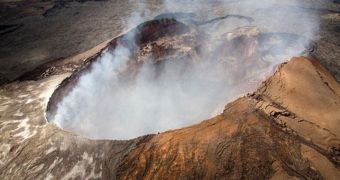Planetary scientists and geologists have always been curious to learn why the Pacific Ring of Fire and other similar regions appear around the world, and new investigations are helping put things into perspective.
The Ring of Fire is the generic name given to a circle-like pattern of volcanoes and seismically active areas that surround the Pacific Ocean, from Japan and Australia to North and South America.
Part of this massive system are volcanoes in Japan, the San Andreas fault line, the Nazca plate that slams into South America and the Juan de Fuca plate in North America.
The mystery of this region is why so much tectonic “potential” has been focused so narrowly. In a new study, experts discovered that is this has everything to do with a mixture of magma, colling water and other liquids that combine beneath Earth's surface.
Volcanic arcs are the main indicators of tectonic activity in an area. They usually occur where two large tectonic plates meet and grind against each other, pushing the crust up to form volcanic mountains.
The Aleutian Islands off the coast of Alaska are an example of this. They are made up of partially submerged volcanoes. Iceland is another example of land appearing at the intersection of large plates.
“It has been recognized for almost 50 years that the volcanic arcs form where one oceanic plate sinks beneath another,” explains Oxford University expert Phillip England.
“But while many models of this process have been put forward, none have been able to explain the location, and narrowness, of the volcanic arcs,” the expert adds, quoted by Our Amazing Planet.
These arcs are very dangerous when they erupt because the magma under them contains a lot of water. High temperatures make it into a superheated gas, which contributes to increasing the strength of the eruption.
Additionally, the water also lowers the melting temperature of rocks, making it easier for them to be converted to large amounts of magma, which is then added to existing quantities.
“Most previous explanations for the origins of volcanoes suggested that this kind of 'wet' melting is responsible for getting a volcano started,” adds Oxford expert Richard Katz.
But the presence of water alone was not enough to explain the Pacific Ring of Fire, and so experts turned to using a mathematical model to understand the phenomenon.
Counter-intuitively, the model revealed that arcs appear to develop in areas of tectonic plate intersections that featured no water at all.
In a study published in the October 7 issue of the top journal Nature, the investigators also show that studying volcanoes is important for understanding how life evolved on our planet.
The landscape features release a vast array of particles into the air, which may have contributed to setting the stage for the development of the earliest life forms on Earth.

 14 DAY TRIAL //
14 DAY TRIAL //